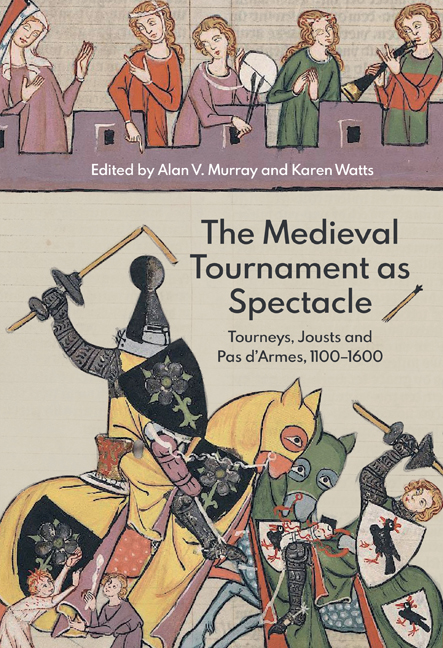Book contents
- Frontmatter
- Contents
- List of Illustrations
- List of Contributors
- Preface and Acknowledgements
- Introduction: From Mass Combat to Field of Cloth of Gold
- Research on the Medieval Tournament (1100–1600): A Select Bibliography
- 1 Now Form Up Close Together! Tactics and Ethos of the Tourney in Early German Sources (Twelfth to Thirteenth Centuries)
- 2 Por pris et por enor: Ideas of Honour as Reflected in the Medieval Tournament
- 3 Richard II of England and the Smithfield Tournament of October 1390: An Instrument to Establish Royal Authority
- 4 Alle myn harneys for the justes: Documents as a Source for Medieval Jousting Armour
- 5 The Tournament Saddle
- 6 Between Sport and Theatre: How Spectacular was the Pas d’armes?
- 7 Art Imitating Life Imitating Art? Representations of the Pas d’armes in Burgundian Prose Romance: The Case of Jehan d’Avennes
- 8 The Foot Combat as Tournament Event: Equipment, Space and Forms
- 9 Power and Pageantry: The Tournament at the Court of Maximilian I
- 10 The Field of Cloth of Gold: Arms, Armour and the Sporting Prowess of King Henry VIII and King Francis I
- Appendix 1 Calendar of the Royal Combats at the Field of Cloth of Gold, June 1520
- Appendix 2 Articles for the Challenge: The Emprise
- Index of Objects
- Index of Manuscripts
- General Index
Introduction: From Mass Combat to Field of Cloth of Gold
Published online by Cambridge University Press: 11 September 2020
- Frontmatter
- Contents
- List of Illustrations
- List of Contributors
- Preface and Acknowledgements
- Introduction: From Mass Combat to Field of Cloth of Gold
- Research on the Medieval Tournament (1100–1600): A Select Bibliography
- 1 Now Form Up Close Together! Tactics and Ethos of the Tourney in Early German Sources (Twelfth to Thirteenth Centuries)
- 2 Por pris et por enor: Ideas of Honour as Reflected in the Medieval Tournament
- 3 Richard II of England and the Smithfield Tournament of October 1390: An Instrument to Establish Royal Authority
- 4 Alle myn harneys for the justes: Documents as a Source for Medieval Jousting Armour
- 5 The Tournament Saddle
- 6 Between Sport and Theatre: How Spectacular was the Pas d’armes?
- 7 Art Imitating Life Imitating Art? Representations of the Pas d’armes in Burgundian Prose Romance: The Case of Jehan d’Avennes
- 8 The Foot Combat as Tournament Event: Equipment, Space and Forms
- 9 Power and Pageantry: The Tournament at the Court of Maximilian I
- 10 The Field of Cloth of Gold: Arms, Armour and the Sporting Prowess of King Henry VIII and King Francis I
- Appendix 1 Calendar of the Royal Combats at the Field of Cloth of Gold, June 1520
- Appendix 2 Articles for the Challenge: The Emprise
- Index of Objects
- Index of Manuscripts
- General Index
Summary
Five hundred years ago, from 7 to 24 June 1520, the kings of England and France held a series of meetings on the frontiers of their respective domains, between the settlements of Guînes, situated in the English-held territory of Calais, and Ardres, in the kingdom of France, an event that has come to be known from its sumptuousness and magnificence as the Field of Cloth of Gold. Both monarchs were young men. Henry VIII of England (born 28 June 1491) was only weeks short of his twenty-ninth birthday; Francis I of France (born 12 September 1494) was three years younger. At what was in effect a political summit between the rulers of two of Europe's most powerful kingdoms, each man wished not only to display the splendour of his own realm and court, but to demonstrate his personal vigour and virility, and so alongside diplomatic negotiations, feasting and entertainments, much time was devoted to jousts, tourneys and foot combats, in which both kings and members of their respective nobilities took part. The Field of Cloth of Gold thus demonstrates the importance of tournaments not only as a noble pastime, but as a fundamental expression of courtly culture.
Henry VIII and Francis I were monarchs at the beginning of the early modern age, but in their enthusiasm for tournaments they were following a long medieval tradition. The earliest form of tournament originated in the late eleventh century as a military exercise in which knightly retinues could practise riding and fighting in formation. The tourney (sometimes described as a melée) was a form of training for mounted combat which encouraged cohesion and group discipline, while also offering the opportunity for participants for financial gain through ransoms or by capturing the horses of opponents. In some cases tourneyers might achieve renown for their prowess, although the physical circumstances of the earliest tourneys, often fought over long distances, did not favour the presence of spectators. This is one reason why in the twelfth century, tourneys often came to be preceded by jousting, which functioned on a more or less informal basis. In contrast to the mass combat of the tourney, a joust at this time featured a pair of knights, each of whom would try to strike (and ideally unhorse) his opponent with his lance.
- Type
- Chapter
- Information
- The Medieval Tournament as SpectacleTourneys, Jousts and Pas d'Armes, 1100-1600, pp. 1 - 6Publisher: Boydell & BrewerPrint publication year: 2020

